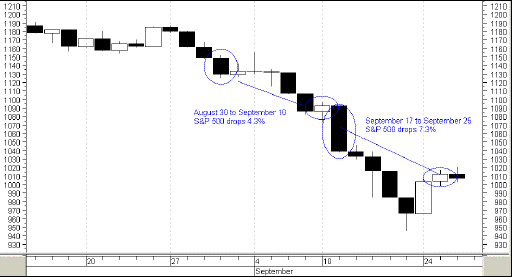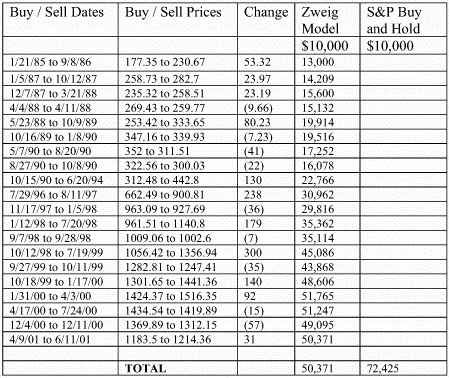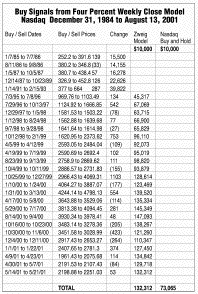
HOT TOPICS LIST
- Strategies
- Stocks
- Buy
- Investing
- Brokers
- Psychology
- Interviews
- Accumulate
- Sell
- Hold
- Spotlight
- Websites
- Candlestick Corner
- Gold & Metals
- Options Trading
LIST OF TOPICS
MARKET COMMENTARY
An Autumn Of Infamy
11/05/01 03:31:28 PM PSTby David Penn
A catastrophic terrorist attack on the United States sets the stage for a not entirely unexpected stock market collapse.
What did we know? And when did we know it? That has been the form of the quintessential question of political accountability in the United States ever since US Senator Howard Baker rhetorically cornered President Richard Nixon during the Watergate hearings of the 1970s. Indeed, from Ford to Carter, Reagan to Bush to Clinton and back to Bush again, these immortal words have been repeated in one context or another as those who often were not paying particularly close attention in the first place looked furiously about for someone, anyone, who could have warned us, who could have known before the rest of us knew there was anything to know about. Thus, Senator Robert Torrecelli (D-NJ) demands that the US Senate hold hearings to find out how the terrorist attacks on September 11, 2001, could have happened in the first place. And while there is no doubt that an embarrassing number of security lapses — at a variety of levels — exist to be uncovered by Torrecelli's longed-for investigation, there is doubt that much solace will be found in a pursuit of minimum-wage airport security workers or questionable flight school instructors from the backwaters of Florida. For better or worse, the stock market needs no such Congressional investigation to discover the reasons for its September of discontent. While both the initial terrorist attack and the threat of subsequent attacks were and are powerful catalysts, the fact of the matter is that the equity markets had been in very weak shape going into autumn anyway. After a summer of little more than churning (see "A Spring And Summer Not To Remember," Working-Money.com), investors nervously looked to earnings preannouncements that were almost guaranteed to disappoint. And although it seems commonsensical to say so today, in the wake of the largest point losses in the Dow Jones Industrial Average since the Great Depression, it bears remembering that in the seven trading days leading up to September 11, the Standard & Poor's 500 had lost 4.8% (the S&P was down 3.6% for the month). In the seven trading days after September 11, the S&P 500 lost 7.3%. No small change to lose, on average, 100 basis points per day. But when it is noted that those same seven days included, at one point, a 13% drop, it does bear wondering just how unsettled the markets were by the attacks on September 11.
Figure 1: S&P 500 index. It has become something of patriotic bravado to suggest that, in essence, stocks are tougher than terrorists, that between bargain-hunting and the final thud of some too widely held technology stocks (Exodus, anyone?), not only will we as civilized people endure, but also that our capital markets, as much an emblem of our advancement as anything else, will also endure if even in their tortured, bull-boom, bear-bust way — come hell, high water, or Osama bin Laden. And if the lows marked by the September decline hold — such lows not seen since 1998 — then that may be a bravado, patriotic or otherwise, that is well deserved.
THE EBBING BUY AND HOLDOne philosophy that is rapidly ebbing away with the last of the bull market is undoubtedly the "buy and hold" approach to investing. Taken to its most simplistic extreme (an extreme that has nevertheless been widely adopted — and promoted — over the years), the buy and hold approach to investing believes that there are few really bad stocks. Why? Because, goes the mantra, "Over time, stocks go up." Moreover, they "go up" more than bonds "go up." So even if you have a bad stock, even if you have a bad mutual fund, the message is: "Hang in there, you're in for the long term." But with the bear market now clawing away three years of stock market gains, even the most diehard buy-and-holders may be reconsidering their strategy. In fact, because of losses suffered since 2000, many of these investors may find themselves in for a longer term than they had planned. This is because losses can take a long time to be made up and the larger the loss, the more work that your stock, your mutual fund, or your portfolio will have to do just to catch up. A 45% loss requires a 90% return going forward just to break even. With that in mind, it may be helpful for recovering buy and hold investors to consider ways to systematically minimize their exposure to the stock market when the market turns down and to increase their exposure when the market appears to be headed up. While there are a variety of methods and strategies that long-term investors can use to achieve this selective exposure to the markets, a great many of them are, for the average investor, far more work than they are worth. Martin Zweig's 4% weekly close investment model, on the other hand, is not one of them. Developed by Zweig and first introduced in his seminal work Winning On Wall Street, the method is for investing in the broad market based on strong and weak weekly closes. Specifically, Zweig looked to buy the market whenever the current weekly close was 4% higher than the previous weekly close. Conversely, Zweig looked to sell the market whenever the current weekly close was 4% lower than the previous weekly close. What is compelling about Zweig's 4% model is both its simplicity (all you need is the weekly close) and its excellent track record. In Winning On Wall Street, Zweig applied the 4% model to the Value Line Composite Index from 1966 to 1985 and showed how a $10,000 investment would have grown into $176,596 over that 19-year period, an annualized return of more than 16%. A buy and hold strategy over the same period, he reports, would have realized an annualized return of only 2%. This information may be especially relevant in the event that the next 20-odd years in the stock market look more like the years between 1966 and 1982 and less like the years between 1982 and 2000. Using Zweig's 4%weekly close model during the secular bull market period that began just as his study ended yields interesting results. Looking at the S&P 500 (Figure 2) and the Nasdaq (Figure 3), the model fell somewhat short of a buy and hold strategy in the S&P 500, turning $10,000 into just over $50,000, compared to a buy and hold strategy that yields just over $72,000 for the same period. However, with regard to the Nasdaq, Zweig's model performed sensationally. Over the 17 years from December 1984 to August 2001, $10,000 would have grown into $132,312 using Zweig's 4% weekly close model with the Nasdaq. This compares to only $73,000 using a buy and hold approach.
Figure 3: The 4% weekly close model applied to the Nasdaq.
ANY HOPE FOR BUY AND HOLD?What observations can be made from this, if any? In general, it seems that during exceptionally bullish periods (secular bull markets, if you will) such as between 1982 and 1999, investors are often better off buying and holding. The momentum of the secular bull market is such that even the most exacting timing strategies can struggle to keep pace. In the case of the Nasdaq, the superior performance of the model compared to the buy and hold approach is due largely to taking advantage of the sizable gains of the 1990s and by avoiding the lackluster markets (the model was out of the market during both the 1990 and 1994 bear markets). As the S&P 500 example shows, a buy and hold approach would have served many investors well since 1984. But far from vindicating buy and hold investing, revisiting Zweig's 4% weekly close model helps put buy and hold investing — as a type of investing — in its proper context. That context, in case you missed it, is a bull market, preferably of the long-term, secular variety. Then again, what tradable, what type of investing doesn't look better crowned with horns, shod with hooves and wrapped snugly in cowskin?
David Penn may be reached at DPenn@Traders.com.
SUGGESTED READINGPenn, David [2001]. "A Spring And Summer Not To Remember," Working-Money.com: November.Zweig, Martin [1994]. Winning On Wall Street, Warner Books. MetaStock (Equis International), Yahoo! Finance (data)
Current and past articles from Working Money, The Investors' Magazine, can be found at Working-Money.com. |
Technical Writer for Technical Analysis of STOCKS & COMMODITIES magazine, Working-Money.com, and Traders.com Advantage.
| Title: | Traders.com Technical Writer |
| Company: | Technical Analysis, Inc. |
| Address: | 4757 California Avenue SW |
| Seattle, WA 98116 | |
| Phone # for sales: | 206 938 0570 |
| Fax: | 206 938 1307 |
| Website: | www.traders.com |
| E-mail address: | DPenn@traders.com |
Traders' Resource Links | |
| Charting the Stock Market: The Wyckoff Method -- Books | |
| Working-Money.com -- Online Trading Services | |
| Traders.com Advantage -- Online Trading Services | |
| Technical Analysis of Stocks & Commodities -- Publications and Newsletters | |
| Working Money, at Working-Money.com -- Publications and Newsletters | |
| Traders.com Advantage -- Publications and Newsletters | |
| Professional Traders Starter Kit -- Software | |
PRINT THIS ARTICLE

|

Request Information From Our Sponsors
- StockCharts.com, Inc.
- Candle Patterns
- Candlestick Charting Explained
- Intermarket Technical Analysis
- John Murphy on Chart Analysis
- John Murphy's Chart Pattern Recognition
- John Murphy's Market Message
- MurphyExplainsMarketAnalysis-Intermarket Analysis
- MurphyExplainsMarketAnalysis-Visual Analysis
- StockCharts.com
- Technical Analysis of the Financial Markets
- The Visual Investor
- VectorVest, Inc.
- Executive Premier Workshop
- One-Day Options Course
- OptionsPro
- Retirement Income Workshop
- Sure-Fire Trading Systems (VectorVest, Inc.)
- Trading as a Business Workshop
- VectorVest 7 EOD
- VectorVest 7 RealTime/IntraDay
- VectorVest AutoTester
- VectorVest Educational Services
- VectorVest OnLine
- VectorVest Options Analyzer
- VectorVest ProGraphics v6.0
- VectorVest ProTrader 7
- VectorVest RealTime Derby Tool
- VectorVest Simulator
- VectorVest Variator
- VectorVest Watchdog



